
I had occasionally paid attention to food labels in the past – mainly just to compare grams of sugar in the foods I was buying the girls – but I didn’t really know what to look for besides that. I took a look at the calories, the first and last ingredients on the list, and then tried to make an educated guess.
I thought I was fairly food savvy, to be honest.
It turns out that there is a lot more information to be gleaned from those labels than just calories and “exactly how much sugar is in this special marshmallow cereal I’m buying for this camping trip?”

This past summer, my dad suffered a cardiac event that rocked us. He trudged his way back to recovery – steadily and with good humour – but now with a new diet plan and a pedometer in tow.
And so, our family started talking about sodium. A lot.
It’s pretty much common knowledge that lots of tasty things – chips, fast food, and most restaurant fare – are all loaded with salt. But soon, my mom and dad learned about hidden sodium in many foods. The kinds of foods that many of us would consider staples.
I’m sure we’ve all thought to ourselves, “Oh, I don’t add a lot of salt when I’m cooking.” or “I’m pretty good about sugar. I drink my coffee black.”
But because you aren’t adding MORE doesn’t mean that your diet isn’t full of the stuff already. Your food in the pantry has sugars and fats and sodium and vitamins, and it’s up to us as consumers, home cooks, and parents to know what’s in our food.
Before I started digging into our shelves, Mr. Suburble and I did a little bit of a guessing game with some food from our pantry with a kit that was sent to us from the Nutrition Facts Education Campaign. They’ve launched a new Focus on the Facts site that is aimed at educating us – the people strolling down the aisles at the grocery store – on how to scout out the important information on food labels.
I didn’t do as well as I had hoped.

When looking at the Nutrition Fact label, the first thing is to look at is the serving size. The amount of calories and fat in a food means nothing when you have no idea what the portion size is.
These two cereal boxes have a similar calorie count, until you look at the portions. The one on the right is a 1/4 cup more cereal! So, Cereal B actually contains less than 90 calories per 1/2 cup serving, and far less sugar than Cereal A.
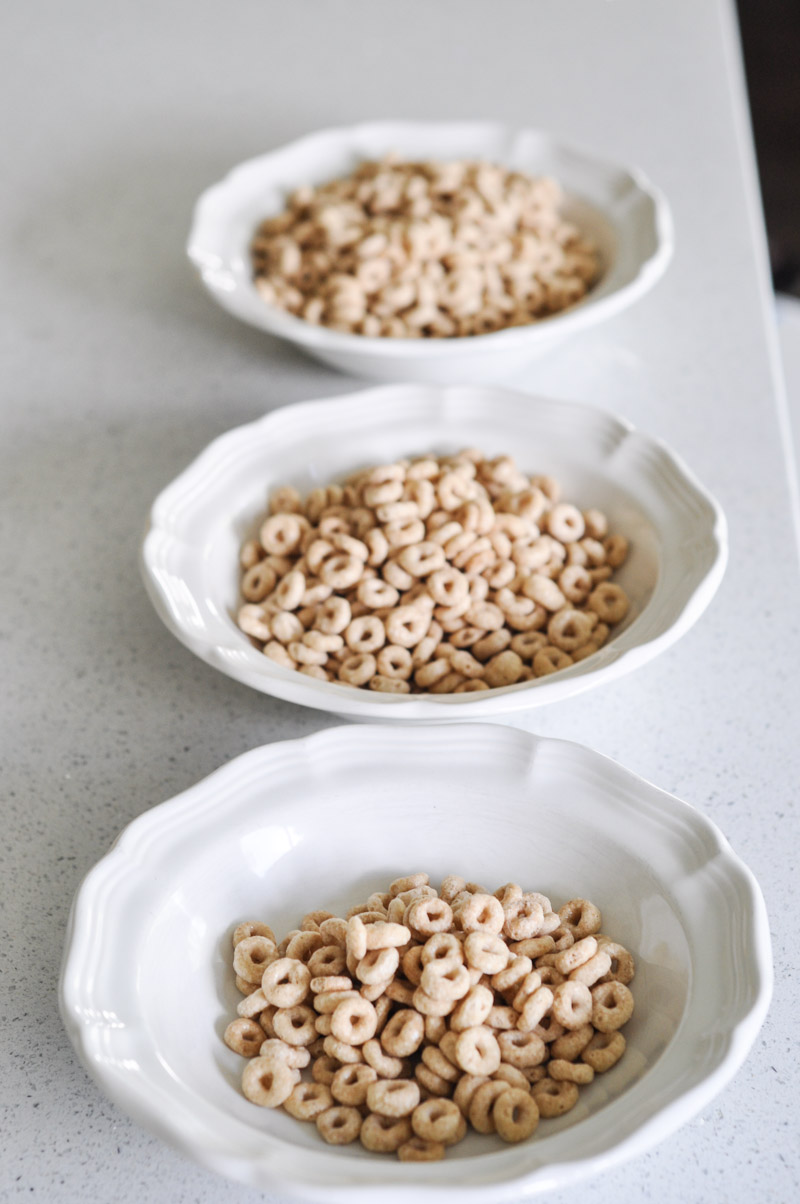
It’s also important to get real with yourself about the actuality of serving size.
In front of you is Cereal B’s serving size – yes, the very first one – sitting in our salad bowl. And this is 50% bigger than Cereal A’s serving size!
The middle bowl is double that. And the furthest bowl is what I would pour myself in a “nom nom nom” fit of late night cereal-gobbling in front of the TV. Somehow I feel like the Fact Sheet wouldn’t know how to keep up with that.
Portion sizes can also make a big difference when it comes to snackier foods. These three portion sizes all have the same calories.
There aren’t heaps of differences between these three crackers, except for the portion size (and ingredients, but that’s a whole other post). Again – it’s about having an honest chat with yourself, “How many crackers do I want to eat right now? Two or four? And what am I pairing them with? What is a REAL serving of this snack?”
Once you’ve examined portion size and compared the bolded categories of Calories, Fat, Cholesterol, Sodium and Protein, you’ll want to let your eyes fall to the right hand side of the chart.
The Daily Value percentage tells you how much of your daily recommended intake of that particular column you’re eating in that serving. Anything over 15% is a lot. Under 5% is a little. We should be wary of our calories, sodium, and fat intakes, but also want to be sure that we’re getting enough fibre and calcium in the day.
I know that there isn’t always a ton of time to take in every number, but do a quick scan and see if any of the numbers seem inflated. You can stop and look more closely when you get to that number.
I’m going to share a recent example of that right here:

I cook with black beans all of the time. I love them as a meat substitute in meals, or I shake ’em on top of my salads.
Take a quick scroll over this fact sheet. Does anything stand out to you?
Yeah. A THOUSAND MILLIGRAMS OF SODIUM. PER CUP.
Holy dinah. That is a LOT of salt.
Before my family became sodium-aware, and before I started looking beyond the “Calories” number on the Fact Sheet, I never would have thought to look that far down on the chart.
Were black beans suddenly on the no-go list? Considering that our daily recommended intake of sodium is 2300 mgs a day, this was a hefty chunk of my “sodium allowance” being gobbled up here.
But this is why it pays to compare. Don’t immediately write off an entire food in one fell swoop.
I picked up another can of beans to see if this number was food-specific or merely brand-specific.
I discovered that another can of black beans has only five milligrams of sodium in its cup-sized serving.
That’s a huge difference. And it is definitely going to change how I shop. If I can get all of the benefits of the great fibre and iron in beans, but without that huge sodium intake, I’ll take it.

It’s about being savvy enough to know what to look for, without agonizing over the choices.
You can have your beans, and eat them too.
The Nutrition Facts Education Campaign (a partnership including Health Canada) has a great resource for learning more about making informed food choices: read more about how to quickly decode Nutrition Fact Labels here.





2 comments
Virginia Fynes
Such good information Tara!! I learned about reading food labels a few years back and it definitely has changed how I shop. So important to teach little minds too!
Tara
You’re so right, Virginia! It’s really important to get the kidlets involved. There’s so much to learn about making good food choices!